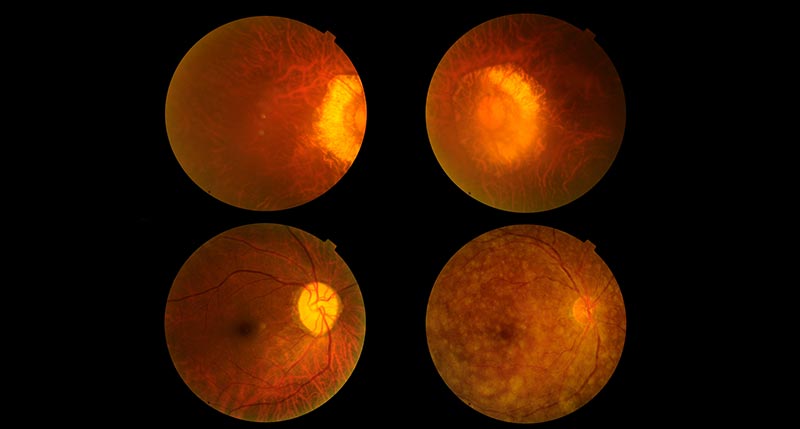February is Age-Related Macular Degeneration and Low Vision Month, a time to promote awareness of these conditions that impact millions of Americans in their daily lives.
You may know someone who has been diagnosed with or is experiencing age-related macular degeneration (AMD). The condition—currently considered incurable—is the prevailing cause of blindness for people over the age of 55 in the United States. Up to 16 million Americans are living with the condition in one of its various stages.
So, what is macular degeneration, and who’s at risk? Here are 5 frequently asked questions about macular degeneration:
- What is macular degeneration?
Macular degeneration is a condition of your eye’s retina. Specifically, the condition is a degeneration of the cells and function of the macula.
What is the macula? The macula is a small cluster of highly specialized cells in your retina measuring about 5 millimeters in size—about the diameter of a pencil eraser. The macula is responsible for very fine, detailed, central vision and color vision.
When the macula degenerates, it leads to a loss of detailed central vision and can impact a person’s ability to read, write, drive, watch tv, see your cell phone screen, and perform other daily activities. People diagnosed with macular degeneration often experience strong emotions about their condition at first, fearing they will lose their independence and ability to enjoy life.
- Who’s at risk for age-related macular degeneration?
AMD has genetic, race, age, and lifestyle components. As you can tell from the name of the disease, AMD is an age-related condition. While it typically impacts people age 55 or older, there are people much younger who have been diagnosed in their 30s or 40s.
The typical patient is white, over age 50, and may have a family history of the disease. Additional risk factors include smoking, overweight, high blood pressure, and a diet high in saturated fat (meat, cheese and butter).
- What are the early symptoms of AMD?
While the condition isn’t painful in a physical sense, people with early symptoms of macular degeneration might start to experience blurred central vision. Straight lines such as text on a page might look distorted or wavy. Seeing well in low-light situations is difficult, and they may have increased sensitivity to glare. As the condition progresses, patients describe it as a black hole in the center of their vision.
The condition is diagnosed during a comprehensive eye exam with dilation so that your optometrist can clearly see into the back of your eye and examine the retina. Your optometrist might also take a picture of your eye with an Optical Coherence Tomography (OCT) machine. This gives a detailed image of your retina in cross-sections of its layers to more accurately assess the condition.
- What is the treatment for AMD?
Because there isn’t a cure for AMD, the condition must be carefully managed. Any vision loss is likely gone forever, so treatment focuses on slowing the progression of the condition and preventing further deterioration of the macula.
A healthy lifestyle is key. If you’re a smoker, stop smoking immediately. Start making healthy choices including a whole-foods-based diet, regular exercise, maintaining a healthy body weight, avoiding smoking or second-hand smoke, and wearing sunglasses to protect eyes from the sun’s damaging UV rays. These are all important steps toward managing AMD.
Your optometrist may prescribe vitamins to support your eyes and their cell structures. Depending on the specific type of AMD you have – wet or dry – there are additional therapies that may help slow the disease progression. These include laser photocoagulation treatment to seal off leaky vessels, and injections with medicine that prohibit the growth of new, weak blood vessels behind the retina. Advancements in AMD treatment are made each year, and there is reason for optimism in managing the condition moving forward.
- What is life like for people with AMD?
A diagnosis with AMD is significant in the lives of our patients. Many experience depression at the likelihood that their vision loss is progressing and may eventually result in becoming legally blind.
Losing your central vision can significantly impact quality of life; there is a big lifestyle adjustment to be made. First, closely following your optometrist’s treatment plan is extremely important to slow the progression of your vision loss.
Lifestyle adjustments that may benefit patients living with AMD include:
- Install additional under-cabinet and overhead lighting to brighten spaces
- Use contrasting colors to increase visibility in areas such as the kitchen, stairs, or bathroom
- Remove throw rugs or tape them down securely
- Install secure handrails along stairwells and in bathrooms
- Organize frequently used items so you’ll always know where to find them
- Use assistive devices that read text aloud
- Use magnifiers with lights attached
- Switch to large-print books
- Choose enhanced text options on phones and devices
If you have difficulty reading this text or notice any changes in your visual field or visual acuity, call our office today to schedule your annual comprehensive eye exam. As with so many health challenges, early detection of age-related macular degeneration is the best path to slowing its progression and preserving your vision.





